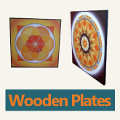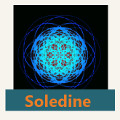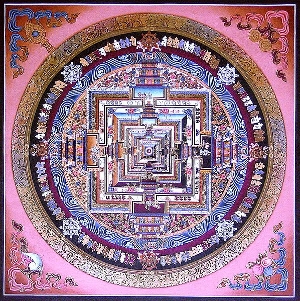 |
The word Mandala comes from sanscrit and means "sacred circle", center or unit.
It is expressed in a circular drawing, converging towards a center. In India and Tibet Mandalas are based on an ancient tradition. They represent the macrocosm and the microcosm, the world that extends both beyond and within our bodies and minds. The word Mandala means at the same time, circle and center, implying that it represents both the visible world outside us and the invisible world in our deepest inner being.
It is usually represented in two dimensions, but one also finds Mandalas realised in three dimensions.
The Tibetan Buddhist Mandalas are works of art of great complexity. The meditator projects himself into the Mandala and fuses to it. Each detail of the Mandala has a meaning and it needs long studies to know the significances. This intellectual approach is necessary but the direct meditative experiment takes precedence over intellectual knowledge. There also exist two-dimensional Mandalas, made with coloured sans during elaborate rituals. These Mandalas are then destroyed to symbolize the impermanency and the transitional character of phenomenons. This also helps fighting against attachment.
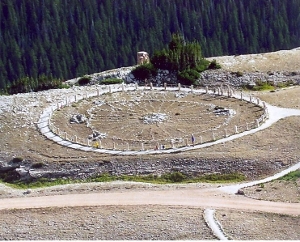 Medicine Wheel, Bighorn National Forest, Wyoming, USA Medicine Wheel, Bighorn National Forest, Wyoming, USA |
Sacred Circles are also found in the West. One example are the Native American medicine wheels, traditionally made of stones forming a circle and rays like a wheel. These stone circles represent the cycle of life, the seasons, the development of human beings. The creation of a medicine wheel expresses the relationship between man, nature and the cosmos.
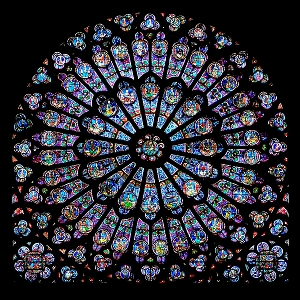 |
In Europe, the beautiful rosettes found in gothic cathedrals, are another form of expression of Mandalas. Genuine laces of stone, glass and lead, they symbolize the growth and fulfilment of the soul.The petals of the gothic rosette are populated by the saints of Christianity while the center is occupied by a representation of God, Christ or the Virgin.
The Mandalas, these centered and regular forms are thus present in most traditions. But nature proposes also man forms that can be perceived as Mandalas. Think of snow cristals, starfish, sea urchins, many flowers and fruits ... Illustrations of what can be called "natural Mandalas" can be found in the book (in German) "Kunstformen der Natur" (which can be translated by "art forms in nature", by Ernst Haeckel, with remarkable drawings of living organisms of an extraordinary beauty. http://caliban.mpiz-koeln.mpg.de/haeckel/kunstformen/natur.html (You can download the book in pdf format by clicking the link "Dieses Buch im pdf Format")
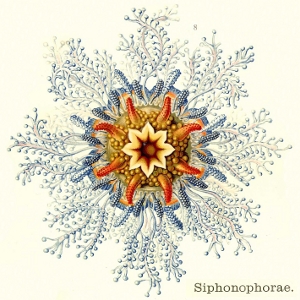 |
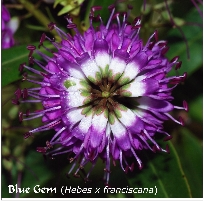 |
 |
In fact, Mandalas are present everywhere around us. Even at a microscopic level, electrons revolve around the atomic cores forming marvellous Mandalas.
Each Mandala, wether it is naturally present in nature, or created by humans, is a representation of the energies of the universe in interaction with our psychic functioning.
It is Carl Gustav Jung who first introduced Mandalas in psychology. He defines the Mandala as a symbol of "Self". He believed that the Mandala can help a person to discover his full potential and to unify and balance his personality. He used Mandalas in the treatment of mental health disorders. In people with depression benefic effects appear by the action of centring.
 Since then, Mandalas are used in Art-Therapy, personal development, psychotherapy, ...
Since then, Mandalas are used in Art-Therapy, personal development, psychotherapy, ...
The "Mandala-therapy" is a way for therapists to learn more about the inner state of the person who draws the Mandala. Its way of drawing and distributing the colors reveals its anguishes and desires. A person drawing a Mandala gives colors to his mood of the moment. While making evolve the Mandala, the person starts a process of transformation and harmonization ...It is interesting to note that children from approximately three to seven years draw spontaneously images similar to Mandalas.
Working with Mandalas is also a very good method of relaxation and to manage stress. It also helps to better concentrate and allows everyone to release his creative energy. It is a way to get in touch with our creative potential.
There are different ways to work with a Mandala:
- creation of a Mandala (eg with a compass or freehand)
- coloring of Mandalas whose contours are already traced
- observation or contemplation of existing Mandalas to encourage a state of meditation
Whatever method is chosen, the Mandalas have a structuring function that can guide us in a dimension that is beyond the mind. We slide gradually into a state which makes emerge our interior world and where the external things lose more and more of their importance.
Whether we consider the Mandalas as a sacred ritual, a therapeutic tool or an art object, whether we use it as a support for meditation or contemplation, for relaxation or rebalancing or to reveal unconscious resources in us, whether we use it as a therapeutic tool, to harmonize a place or simply to decorate a space, they stir us and awake feelings that come from deep within ourselves.
The Mandala is the reflection of ourselves in the exact moment when our eyes feel in harmony with it.
Let's guide yourself, fascinate and amaze by the energy of Mandalas.
I invite you to discover my Mandala creations (Mandalas on wood, ceramics, pendants, ...)
Enter in communication with Mandalas.
Let yourself be touched.
Listen to your heart.
Mireille Dondlinger







